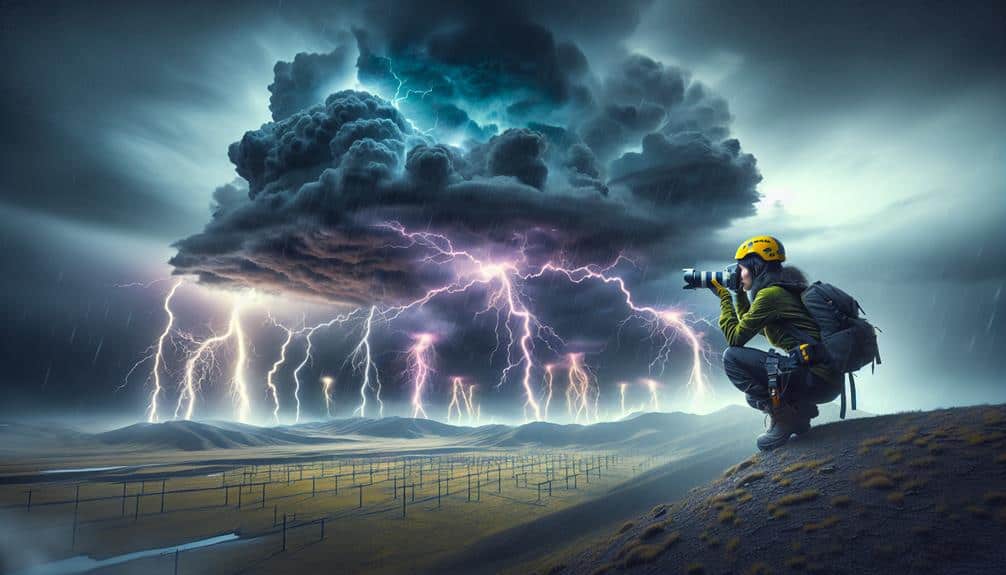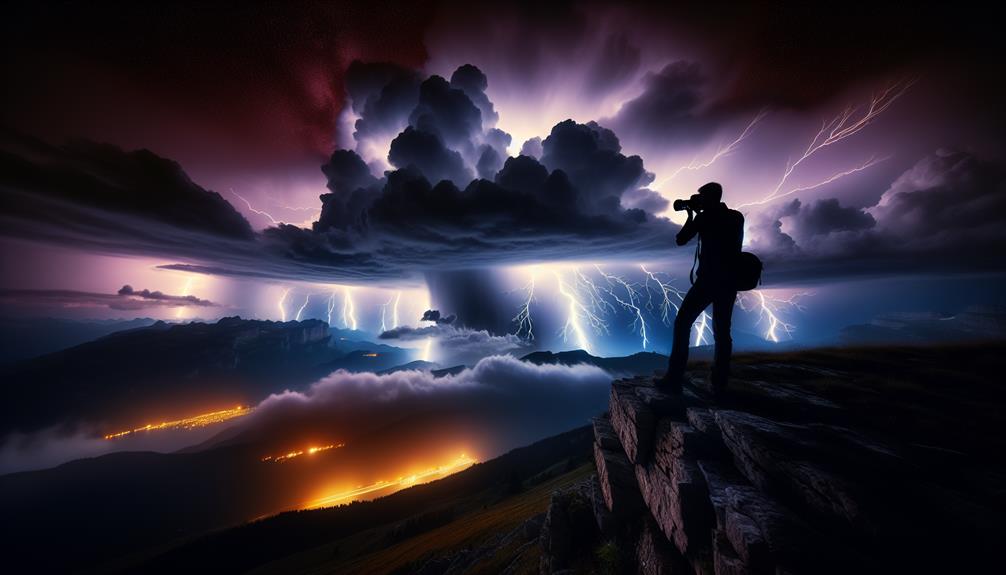We observe that lightning strike variability stems from the interplay of atmospheric pressure, temperature gradients, humidity, wind patterns, altitude, and seasonal changes. High-pressure systems bring stability, reducing lightning, while low-pressure systems increase it. Temperature variations drive convective currents, enhancing storm intensity and electrical charge buildup. Moist air boosts conductivity, elevating lightning probability. Wind shear shapes storm dynamics, and altitude-induced pressure differences expedite storm formation. Seasonal shifts, particularly in warmer months, further affect lightning frequency. By examining these factors, we can uncover more insights into the mechanics of lightning in different weather conditions.
Key Points
- Low-pressure systems and dynamic weather patterns lead to increased lightning activity.
- Temperature gradients influence electrical charges within storm clouds, affecting lightning frequency and intensity.
- High humidity enhances air conductivity and ionization, increasing the likelihood of lightning strikes.
- Seasonal temperature changes result in more lightning during warmer months due to intense convective storms.
Atmospheric Pressure Differences
Due to variations in atmospheric pressure, we observe significant changes in the frequency and intensity of lightning strikes. When atmospheric pressure fluctuates, it directly influences weather patterns and storm formation. High-pressure systems typically lead to stable weather conditions, reducing the likelihood of severe thunderstorms and, consequently, lightning activity.
Conversely, low-pressure systems are associated with more dynamic weather patterns, often leading to the development of thunderstorms. In low-pressure environments, warm, moist air rises and cools, condensing to form clouds. This process releases latent heat, further energizing the storm system. The result is a higher potential for lightning as the electrical charges within the storm clouds become more pronounced.
Data shows that regions experiencing frequent low-pressure systems, such as those within the tropics, tend to report a higher incidence of lightning strikes. Moreover, the rapid formation of cumulonimbus clouds in low-pressure areas enhances the likelihood of electrical discharges. By analyzing atmospheric pressure data, we can predict storm formation and, in turn, anticipate lightning activity with greater accuracy.
This understanding not only aids in weather forecasting but also empowers us to take precautionary measures, ensuring our safety and preserving our autonomy in the face of nature's unpredictability.
Temperature Variations
Temperature variations profoundly impact the occurrence and intensity of lightning strikes, as they directly influence atmospheric instability and moisture content. When temperatures rise, we observe increased thermal expansion in the air masses. This expansion reduces air density, creating an environment ripe for convective currents. These currents are essential for forming thunderstorms, which are breeding grounds for lightning.
Furthermore, heat conduction plays a pivotal role in how temperature gradients are established within the atmosphere. During the day, the Earth's surface absorbs solar radiation, heating the lower atmosphere. This heat is then conducted upwards, creating a temperature gradient that enhances vertical air movement. As warm air ascends and meets cooler air at higher altitudes, the destabilization of these layers results in the formation of cumulonimbus clouds, the primary generators of lightning.
Data supports that regions with significant temperature variations, such as equatorial and temperate zones, experience more frequent and intense lightning strikes. For example, the Florida Peninsula, known for its warm, humid climate and daily temperature fluctuations, records one of the highest lightning strike densities in the world.
Understanding these temperature-driven mechanisms provides us with the freedom to anticipate and mitigate the risks associated with lightning in varying weather conditions.
Humidity Levels
Let's examine how humidity levels influence lightning strikes by affecting conductivity, cloud formation dynamics, and electrical charge distribution.
Higher humidity increases air conductivity, facilitating the movement of electrical charges.
Additionally, humidity impacts cloud formation, which in turn alters the distribution of electrical charges necessary for lightning initiation.
Impact on Conductivity
Humidity levels greatly influence the conductivity of air, directly affecting the likelihood and intensity of lightning strikes. When humidity is high, the air contains more water vapor, which increases its ability to conduct electricity. This increased conductivity facilitates the ionization effects necessary for lightning to form. As water molecules in the air become ionized, they create a conductive pathway, making it easier for lightning to travel from clouds to the ground.
Soil composition also plays a pivotal role in this process. Different types of soil have varying levels of moisture retention and mineral content, both of which can affect ionization. For instance, clay-rich soils, which retain more moisture, can enhance the conductivity of the ground, thereby influencing lightning strike patterns.
Topographical influences and precipitation rates further complicate the picture. Elevated areas with higher precipitation rates are more likely to experience frequent lightning strikes due to the increased humidity and moisture in the soil. Mountainous regions often exhibit these conditions, creating hotspots for lightning activity.
Cloud Formation Dynamics
Cloud formation dynamics hinge critically on variable moisture levels, as the amount of water vapor in the air directly influences the development and characteristics of clouds. When moisture levels rise, the air becomes saturated with water vapor, promoting cloud formation through condensation. This process is crucial in understanding the precipitation effects and lightning initiation in various weather conditions.
As we explore further, consider these key factors:
- Convective Processes: High moisture fuels convective processes, causing warm, damp air to rise rapidly. This vertical motion is essential for thunderstorm development as it aids in the formation of cumulonimbus clouds, which are highly conducive to lightning initiation.
- Precipitation Effects: Increased water vapor leads to higher precipitation rates. Heavier rainfall can enhance electrical activity within clouds, thereby increasing the frequency and intensity of lightning strikes.
- Atmospheric Instability: Elevated moisture levels contribute to atmospheric instability. When the air is unstable, it encourages the development of severe thunderstorms, which are more likely to produce frequent and intense lightning.
Electrical Charge Distribution
The intricate relationship between humidity levels and electrical charge distribution within clouds greatly influences the occurrence and intensity of lightning strikes. When we examine how atmospheric moisture affects charge accumulation, we find that higher humidity levels often facilitate the buildup of electrical charges.
Water vapor acts as a medium for ionization, increasing the overall voltage potential within clouds. This elevated voltage potential can lead to more frequent and intense lightning events, as the disparity between positive and negative charges within the cloud and between the cloud and the ground becomes more pronounced.
We need to take into account that in drier conditions, the charge accumulation process is less efficient. The lack of moisture means fewer ions are available to carry electrical charges, thereby reducing the voltage potential within the cloud. This not only decreases the likelihood of lightning strikes but also their intensity.
By contrast, in more humid environments, the ionization process is enhanced, permitting a greater separation of charges and consequently raising the probability of lightning discharges.
Understanding the role of humidity in electrical charge distribution helps us predict lightning activity more accurately. By doing so, we gain a deeper appreciation of the dynamic nature of weather systems and their impacts on our freedom to explore and interact with the natural world safely.
Wind Patterns
Driven by regional pressure systems, wind patterns play a pivotal role in influencing the frequency and distribution of lightning strikes. Wind circulation patterns, shaped by atmospheric dynamics, dictate how air masses move and interact. These movements are essential for storm formation and, consequently, the lightning distribution we observe.
As we explore further, three key factors emerge:
- Convergence Zones: Areas where winds meet can lead to the rising of warm, moist air, enhancing thunderstorm activity. These zones are often hotspots for frequent lightning strikes.
- Jet Streams: High-altitude jet streams can steer storm systems, concentrating storm formation in specific regions. This steering effect can lead to localized increases in lightning activity.
- Wind Shear: Variations in wind speed and direction with altitude, known as wind shear, can intensify storms by tilting and organizing them, thereby increasing the likelihood of lightning.
Altitude Effects

Let's examine how altitude influences lightning strikes by focusing on atmospheric pressure differences and temperature gradient effects.
Higher altitudes typically exhibit lower atmospheric pressure, which can affect the formation and frequency of lightning.
Additionally, temperature gradients at varying altitudes play an essential role in the development of electrical charges within storm clouds.
Atmospheric Pressure Differences
Changes in atmospheric pressure at varying altitudes greatly influence the frequency and intensity of lightning strikes. When we examine these pressure differences, we see a direct correlation with storm formation and lightning prediction.
High-altitude regions often experience lower atmospheric pressure, which can expedite storm development. This is due to the enhanced uplift of air masses, leading to more vigorous convection currents.
To better understand this, let's break it down:
- Storm Formation: At higher altitudes, reduced pressure facilitates the swift ascent of moist air. This upward movement is essential for storm clouds to form, increasing the likelihood of lightning.
- Lightning Prediction: By analyzing atmospheric pressure data, we can forecast potential lightning events with greater precision. Lower pressures signal increased storm activity, helping us anticipate lightning strikes.
- Frequency and Intensity: Variations in pressure affect the electrical charge separation within storm clouds. Lower pressures often result in more intense and frequent lightning strikes.
These insights allow us to predict and prepare for lightning more effectively, enhancing our freedom to plan outdoor activities safely. By understanding the role of atmospheric pressure, we gain a potent tool in weather forecasting and risk management.
Temperature Gradient Influence
Examining the temperature gradient's impact on lightning reveals how varying altitudes influence the thermal dynamics critical for storm development. As we ascend through the atmosphere, the temperature decreases, creating a gradient that profoundly affects heat conduction within storm clouds. This gradient is pivotal in forming the updrafts and downdrafts essential for thunderstorm activity.
We find that a steep temperature gradient at higher altitudes intensifies these vertical air movements. This results in greater separation of electrical charges within clouds, fostering conditions ripe for lightning strikes. Conversely, a more gradual gradient can dampen these movements, reducing the frequency and intensity of lightning.
When we analyze weather patterns, it's evident that regions with sharp altitude-induced temperature changes—such as mountainous areas—experience more frequent and powerful lightning events. The interplay between altitude and temperature gradient also explains why lightning is more common in summer when surface heating is at its peak, creating a stronger gradient.
In essence, understanding how altitude affects the temperature gradient and heat conduction within clouds enables us to predict lightning patterns more accurately. By doing so, we can better appreciate the complex mechanisms driving these spectacular natural phenomena.
Seasonal Changes
Seasonal changes greatly influence the frequency and intensity of lightning strikes, with distinct patterns observable during different times of the year. We observe that lightning patterns and seasonal trends correlate strongly with temperature variations and atmospheric instability. Analyzing these trends can provide insights into the broader climatic mechanisms at play.
- Spring and Summer: During these warmer months, we see a significant increase in lightning activity. The higher temperatures cause more intense convective storms, leading to heightened storm intensity and frequent lightning strikes. Data from the National Lightning Detection Network reveals that nearly 70% of annual lightning strikes in the U.S. occur between June and August.
- Fall: As temperatures start to drop, the frequency of lightning strikes decreases. However, fall can still produce severe storms known for their intense lightning, particularly in regions shifting from hot to cool weather. These changing periods can create volatile atmospheric conditions conducive to lightning.
- Winter: Lightning is least common during winter months due to colder temperatures and reduced atmospheric instability. Nonetheless, we shouldn't overlook winter thunderstorms, which, though rare, can produce powerful lightning, especially in coastal and mountainous regions where warm and cold air masses interact.
Frequently Asked Questions
How Does Lightning Form?
In thunderstorm development, lightning forms when updrafts and downdrafts create electrical charge separation within clouds. The electrical discharge occurs as the accumulated charges seek to equalize, resulting in a sudden release of energy.
Can Lightning Strike the Same Place Twice?
Contrary to popular belief, lightning frequency isn't limited by location; it can indeed strike the same place twice. By debunking this common misconception, our comprehension is that lightning's behavior is influenced by atmospheric conditions and conductive surfaces.
What Are the Dangers of Being Struck by Lightning?
When discussing the dangers of being struck by lightning, we focus on medical consequences like burns and cardiac arrest. Prevention is key; survival tips include seeking shelter. Myths about safety abound, but data-driven strategies save lives.
How Can You Stay Safe During a Lightning Storm?
During a lightning storm, we must seek shelter to guarantee lightning safety. Contrary to myths, staying indoors is the safest. Data shows that 33% of lightning injuries occur outdoors, highlighting the importance of taking precautionary measures.
Do Different Types of Clouds Affect Lightning Frequency?
Analyzing the current question, we find that different cloud types notably impact lightning frequency. Cumulonimbus clouds, driven by specific weather patterns, increase lightning behavior, while stratiform clouds show lower frequencies, highlighting the complex dynamics of atmospheric conditions.


